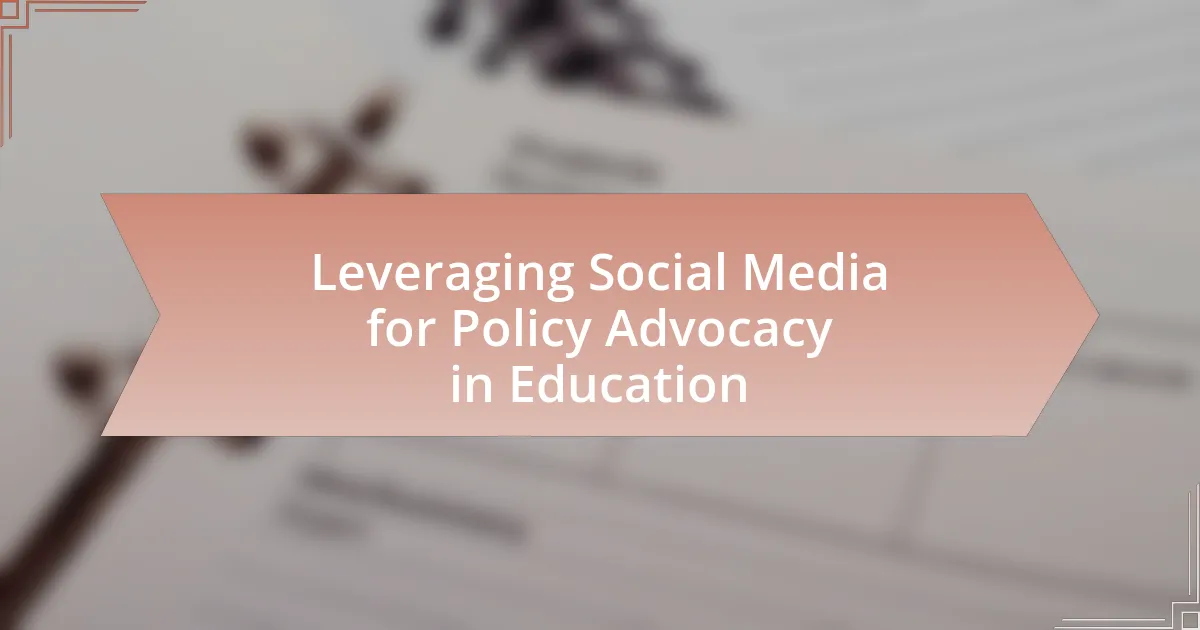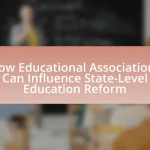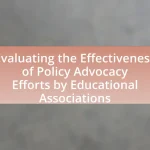Leveraging social media for policy advocacy in education involves using platforms such as Twitter, Facebook, and Instagram to influence educational policy and engage various stakeholders. The article explores how social media facilitates communication, mobilizes support, and disseminates information effectively, highlighting successful campaigns like #SaveOurSchools and #RedForEd. It examines the effectiveness of different platforms, demographic engagement patterns, and the importance of combating misinformation. Additionally, the article discusses strategies for effective advocacy, the measurable impacts of social media on education policy, and future trends in this domain, providing practical tips for enhancing advocacy efforts.

What is Leveraging Social Media for Policy Advocacy in Education?
Leveraging social media for policy advocacy in education involves utilizing platforms like Twitter, Facebook, and Instagram to influence educational policy and engage stakeholders. This approach allows educators, advocates, and organizations to disseminate information, mobilize support, and create awareness about educational issues. For instance, campaigns such as #SaveOurSchools have successfully rallied public support and prompted legislative action by sharing personal stories and data-driven insights. Research indicates that social media can enhance civic engagement, with a study by the Pew Research Center showing that 69% of adults in the U.S. use social media, making it a powerful tool for advocacy efforts.
How can social media be utilized in educational policy advocacy?
Social media can be utilized in educational policy advocacy by facilitating communication, mobilizing support, and disseminating information effectively. Platforms like Twitter and Facebook allow advocates to share research, engage with stakeholders, and rally community support for educational reforms. For instance, the hashtag #EdChat has been used to connect educators and policymakers, fostering discussions that influence policy decisions. Additionally, studies show that social media campaigns can increase public awareness and participation in educational issues, as evidenced by the 2018 #RedForEd movement, which mobilized thousands of educators to advocate for better funding and policies in various states.
What platforms are most effective for educational policy advocacy?
Social media platforms such as Twitter, Facebook, and LinkedIn are most effective for educational policy advocacy. These platforms facilitate real-time communication, allow for broad audience engagement, and enable the sharing of resources and information quickly. For instance, Twitter’s character limit encourages concise messaging, making it ideal for sharing updates and mobilizing support rapidly. According to a study by the Pew Research Center, 69% of adults in the U.S. use Facebook, which provides a vast audience for advocacy campaigns. Additionally, LinkedIn serves as a professional network where educational leaders can connect and discuss policy issues, enhancing collaboration among stakeholders.
How do different demographics engage with social media for advocacy?
Different demographics engage with social media for advocacy in varied ways, influenced by factors such as age, socioeconomic status, and cultural background. For instance, younger individuals, particularly those aged 18-29, utilize platforms like Instagram and TikTok to raise awareness about educational policies, often employing visual content and trending hashtags to amplify their messages. In contrast, older demographics, such as those aged 30-49, tend to favor Facebook and Twitter, where they share articles and participate in discussions about policy changes, reflecting a preference for more detailed information and community engagement.
Research by the Pew Research Center indicates that 69% of adults use Facebook, making it a crucial platform for advocacy among middle-aged users, while 71% of younger adults use Instagram, highlighting the generational divide in platform preference. Additionally, marginalized communities often leverage social media to address systemic inequalities in education, using platforms to organize campaigns and mobilize support, as seen in movements like #BlackLivesMatter, which has significantly impacted educational policy discussions. This demonstrates that engagement strategies are tailored to the unique characteristics and needs of each demographic group.
Why is social media important for policy advocacy in education?
Social media is important for policy advocacy in education because it facilitates widespread communication and engagement among stakeholders. It allows educators, parents, and advocates to share information, mobilize support, and influence decision-makers quickly and effectively. For instance, a study by the Pew Research Center found that 69% of adults in the U.S. use social media, making it a powerful tool for reaching diverse audiences. Additionally, social media platforms enable real-time feedback and discussions, which can shape policy proposals and highlight community needs. This immediacy and accessibility enhance the ability to advocate for educational reforms and policies that reflect the voices of those directly affected.
What role does social media play in shaping public opinion on education policies?
Social media significantly influences public opinion on education policies by providing a platform for information dissemination and community engagement. Through channels like Twitter, Facebook, and Instagram, stakeholders, including educators, parents, and policymakers, share insights, experiences, and critiques regarding educational reforms. Research indicates that 64% of Americans believe social media has a major impact on their views about education issues, highlighting its role in shaping perceptions and mobilizing advocacy efforts. Additionally, social media enables grassroots movements to gain visibility, allowing diverse voices to contribute to the discourse on education policies, thereby affecting public sentiment and policy decisions.
How does social media enhance communication between stakeholders in education?
Social media enhances communication between stakeholders in education by providing real-time interaction and accessible platforms for dialogue. This immediacy allows educators, parents, students, and policymakers to share information, discuss issues, and collaborate on solutions more effectively than traditional communication methods. For instance, studies show that 78% of teachers use social media to connect with peers and students, facilitating professional development and community engagement. Additionally, platforms like Twitter and Facebook enable stakeholders to mobilize quickly around educational initiatives, share resources, and advocate for policy changes, thereby fostering a more inclusive and participatory educational environment.
What challenges exist when leveraging social media for policy advocacy?
Challenges in leveraging social media for policy advocacy include misinformation, audience fragmentation, and the rapid pace of information dissemination. Misinformation can undermine credibility and distort public perception, as seen in various campaigns where false narratives gained traction, leading to confusion among stakeholders. Audience fragmentation complicates message delivery, as diverse groups may interpret information differently, making it difficult to unify support for a policy. Additionally, the rapid pace of information dissemination can overwhelm advocates, as they must respond quickly to emerging issues and counter-narratives, often without adequate time for thorough analysis. These challenges necessitate strategic planning and effective communication to navigate the complexities of social media in policy advocacy.
What are the risks of misinformation in educational policy discussions on social media?
Misinformation in educational policy discussions on social media poses significant risks, including the distortion of public understanding and the potential for misguided policy decisions. When inaccurate information spreads, it can lead to misinformed opinions among stakeholders, such as parents, educators, and policymakers, which may result in ineffective or harmful educational policies. For instance, a study by the Stanford History Education Group found that 82% of middle school students could not distinguish between a sponsored post and a news article, highlighting the vulnerability of the public to misleading information. This lack of discernment can exacerbate divisions in educational discourse, undermine trust in legitimate sources, and ultimately hinder the development of effective educational strategies.
How can advocates overcome barriers to effective social media engagement?
Advocates can overcome barriers to effective social media engagement by developing targeted strategies that address specific challenges such as audience reach, content relevance, and platform familiarity. For instance, utilizing analytics tools can help identify the demographics and interests of the target audience, allowing advocates to tailor their messages accordingly. Research indicates that posts with visuals receive 94% more views than text-only posts, emphasizing the importance of engaging content. Additionally, training sessions on social media best practices can enhance advocates’ skills, ensuring they are proficient in using various platforms effectively. By implementing these strategies, advocates can significantly improve their social media engagement and influence in policy advocacy within education.
How does social media influence policy change in education?
Social media influences policy change in education by facilitating communication and mobilization among stakeholders, including educators, parents, and policymakers. Platforms like Twitter and Facebook enable users to share information, advocate for specific issues, and organize campaigns that can attract public attention and pressure decision-makers. For instance, the #RedForEd movement effectively utilized social media to advocate for increased funding and better working conditions for teachers, resulting in policy changes in several states. Research indicates that social media campaigns can significantly amplify grassroots efforts, leading to greater visibility and urgency around educational issues, thereby influencing legislative agendas and policy outcomes.
What strategies can be employed for effective social media advocacy in education?
Effective social media advocacy in education can be achieved through targeted messaging, community engagement, and data-driven campaigns. Targeted messaging involves crafting clear, concise, and relatable content that resonates with the audience, ensuring that the educational goals and policies are communicated effectively. Community engagement is crucial; building relationships with stakeholders, including parents, educators, and policymakers, fosters a supportive network that amplifies advocacy efforts. Data-driven campaigns utilize statistics and research to substantiate claims, making the advocacy more credible and persuasive. For instance, a study by the Pew Research Center found that 69% of adults use social media, highlighting its potential reach for educational advocacy.
How can storytelling be used to enhance advocacy efforts on social media?
Storytelling can enhance advocacy efforts on social media by creating emotional connections that resonate with audiences, making complex issues more relatable and engaging. When advocates share personal narratives or case studies, they humanize the issues, allowing followers to empathize and understand the impact of policies on real lives. Research indicates that emotional storytelling can increase engagement rates by up to 300%, as it encourages sharing and discussion among users. This increased interaction amplifies the reach of advocacy messages, fostering a community of support and action around educational policies.
What are best practices for creating engaging content for educational advocacy?
Best practices for creating engaging content for educational advocacy include using clear, relatable language, incorporating storytelling, and utilizing visuals effectively. Clear language ensures that the message is accessible to a broad audience, while storytelling helps to connect emotionally with the audience, making the content more memorable. Research indicates that visual content is processed 60,000 times faster than text, which underscores the importance of using images, infographics, and videos to enhance engagement. Additionally, incorporating data and statistics can provide credibility and support the advocacy message, as evidenced by studies showing that data-driven content is more likely to be shared on social media platforms.
What are the measurable impacts of social media advocacy on education policy?
Social media advocacy significantly influences education policy by increasing public engagement and awareness, leading to measurable changes in policy decisions. For instance, campaigns on platforms like Twitter and Facebook have mobilized communities, resulting in legislative actions such as increased funding for schools or the implementation of new educational programs. A study by the Pew Research Center found that 69% of adults in the U.S. believe social media is an effective tool for raising awareness about important issues, including education. Additionally, specific instances, such as the #RedForEd movement, have demonstrated how coordinated social media efforts can lead to successful strikes and policy reforms in various states, showcasing the tangible impact of online advocacy on educational policy outcomes.
How can success be evaluated in social media advocacy campaigns?
Success in social media advocacy campaigns can be evaluated through metrics such as engagement rates, reach, and conversion rates. Engagement rates, which include likes, shares, and comments, indicate how well the content resonates with the audience. For instance, a campaign that generates a high number of shares suggests that the message is impactful and encourages further dissemination. Reach measures the total number of unique users who see the content, providing insight into the campaign’s visibility. Conversion rates, which track the number of users taking a desired action (like signing a petition or donating), directly reflect the campaign’s effectiveness in achieving its goals. According to a study by the Pew Research Center, campaigns that effectively utilize these metrics can demonstrate a clear correlation between social media activity and real-world policy changes, reinforcing the importance of these evaluation methods.
What metrics should be tracked to assess the effectiveness of advocacy efforts?
To assess the effectiveness of advocacy efforts, key metrics include engagement rates, reach, conversion rates, and policy impact. Engagement rates, such as likes, shares, and comments on social media posts, indicate how well the audience interacts with the content. Reach measures the total number of individuals who see the advocacy messages, providing insight into visibility. Conversion rates track the percentage of individuals who take a desired action, such as signing a petition or contacting a legislator, reflecting the effectiveness of the advocacy in mobilizing support. Lastly, policy impact can be evaluated through changes in legislation or policy outcomes directly linked to the advocacy efforts, demonstrating tangible results. These metrics collectively provide a comprehensive view of advocacy effectiveness in the context of leveraging social media for policy advocacy in education.
What are the future trends in leveraging social media for policy advocacy in education?
Future trends in leveraging social media for policy advocacy in education include increased use of data analytics to tailor messaging, the rise of video content for engagement, and the integration of artificial intelligence to enhance outreach efforts. Data analytics allows advocates to understand audience preferences and optimize their campaigns, as evidenced by studies showing that targeted messaging can increase engagement rates by up to 50%. The popularity of video content, particularly on platforms like TikTok and Instagram, is reshaping how educational policies are communicated, with research indicating that video posts receive 48% more views than static images. Additionally, artificial intelligence tools are being developed to automate responses and analyze public sentiment, which can lead to more effective advocacy strategies. These trends indicate a shift towards more dynamic, personalized, and responsive advocacy efforts in the educational sector.
What practical tips can enhance social media advocacy in education?
To enhance social media advocacy in education, educators and advocates should focus on creating engaging, informative content that resonates with their audience. This can be achieved by utilizing storytelling techniques to share personal experiences and successes, which can foster emotional connections and drive engagement. Additionally, leveraging data and statistics to support claims can enhance credibility; for instance, research shows that social media campaigns that incorporate visual data see a 94% higher engagement rate. Regularly interacting with followers through comments and messages also builds community and trust, encouraging more active participation in advocacy efforts.


